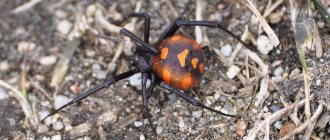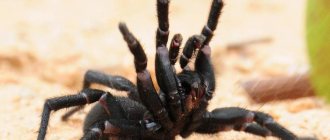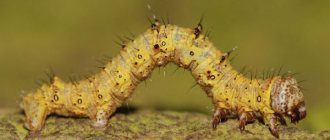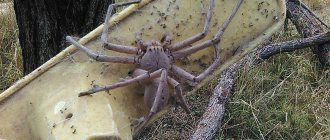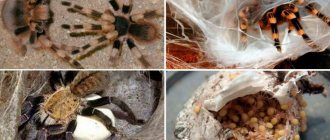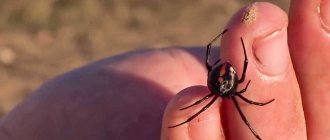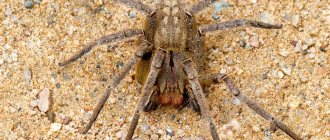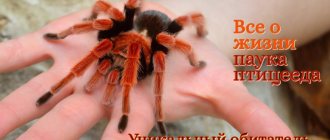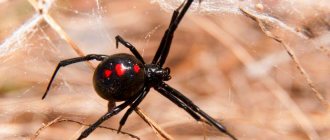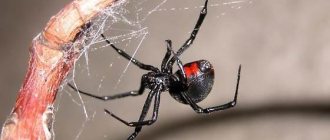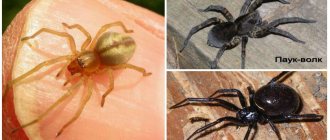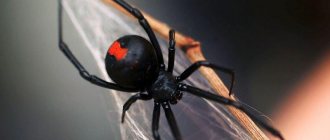Types of spider
| Hobo Spider | |
| Female hobo spider | |
| Scientific classification | |
| Kingdom: | Animalia |
| Type: | Arthropods |
| Subtype: | Chelicerata |
| Class: | Arachnida |
| Order: | Araneae |
| Infraorder: | Araneomorphae |
| Family: | Agelenidae |
| Genus: | Eratigena |
| Variety: | E. agrestis |
| Binomial name | |
| Eratigena agrestis (Walkener, 1802) [1] | |
| Distribution in North America in green | |
| Synonyms [1] | |
| |
Hobo Spider
(
Eratigena agrestis
, formerly
Tegenaria Agrestis
) is a member of the genus of spiders known colloquially as funnel web spiders, but should not be confused with the Australian funnel web spider. Individuals construct a funnel-shaped structure of silken material and wait at the narrow end of the funnel until insect prey stumbles upon their web. Hobo spiders sometimes spin their webs in or around human homes. The hobo spider lays eggs in September and hatches in late spring. After the rogue male mates, he dies. [2]
Toxicity and aggression
The toxicity and aggression of the hobo spider is currently disputed by arachnologists. One common name, aggressive house spider
, may result from a misinterpretation of the Latin name
agrestis
, (lit. "areas") as "aggressive". If a Tramp spider is courting an egg sac, it may become aggressive if it feels the egg sac as threatened. However, they usually do not bite unless prompted to defend themselves.
In the United States, the Hobo spider was considered to be a dangerous species based on a toxicology study of rabbits, where lesions appeared after spiders were forced to bite rabbits. This laboratory research has led to the proposal that in some parts of the US almost all bites attributed to the brown solitary spider are in fact the bite of the hobo spider. The CDC and other US government agencies also used this same study as the basis for a report claiming that the hobo spider bite causes necrosis in humans, despite the absence of any confirmed cases. Subsequent attempts to replicate the study by injecting sufficient venom to ensure envenomation did not produce necrotic lesions, and there is even question as to whether the lesions observed in the original study were necrotic.
In Canada, there are scientists who claim that no hobo spider bites lead to skin necrosis. Hobo spiders are common in Europe, although bites are relatively uncommon, and other than anecdotal reports there is no evidence that they have caused necrosis despite hundreds of years of coexistence there. The only documented case of a verified hobo spider bite resulting in necrotic skin lesions involved a person who had a pre-existing condition (phlebitis) that can also cause skin lesions to appear.
Hobo spider bites are not known to be fatal to healthy people. Necrosis in purported cases is similar to, but milder than, that caused by the brown barb spider, and in severe cases can take months to heal. Other symptoms reported include severe headaches, vision abnormalities and/or a general mood of illness. These symptoms are not confirmed for a hobo spider bite specifically due to the lack of positive identification of the spider by an expert, and the Oregon Venom Center (affiliated with Oregon Health & Science University) has been trying to gather definitive evidence regarding the validity of these reports since September 2007.
Yellow Spider Sac (Cheiracanthium)
The spider, barely 10 mm in size, causes extensive tissue necrosis at the bite site with its venom. It is not fatal, but extremely painful. The golden spider lives in European countries, Australia and Canada. Some experts believe that spiders of this species are responsible for more bites than any other spider.
Preventive measures
When staying in a forest, field, or other places where you may encounter poisonous insects, you need to use special protective equipment, including insect repellent sprays and closed clothing. If you plan to spend the night outdoors, you need to stock up on canopies.
Author of the article: Bespalova Irina Leonidovna
Pulmonologist, Therapist, Cardiologist, Functional Diagnostics Doctor. Doctor of the highest category. Work experience: 9 years. Graduated from Khabarovsk State Medical Institute, clinical residency in therapy. I am engaged in the diagnosis, treatment and prevention of diseases of internal organs, and also conduct medical examinations. I treat diseases of the respiratory system, gastrointestinal tract, and cardiovascular system.
Bespalova Irina Leonidovna published articles: 495
You can prevent and prevent the mass appearance of spiders in your apartment using prevention:
- fix plumbing and pipes. The house should be dry;
- seal all cracks and holes in the walls, windows, floor and ceiling;
- carry out regular cleaning. In a clean house, not only will there be no cobwebs, but also other insects that attract spiders.
Spiders are an unpleasant neighborhood for many people, but they are part of the ecosystem and do not pose a danger to humans. Regular wet cleaning and control of harmful insects at home will be the best protection for your home from spiders.
Where does the water spider live?
Photo: Water spider in Russia
It prefers a temperate climate, and lives in the territories of Europe and Asia located in it - from the Atlantic Ocean to the Pacific. It prefers to live in stagnant water; it is also acceptable for it to flow, but slowly, which means its main habitats are rivers, lakes and ponds. He especially loves abandoned, quiet places, preferably with clean water.
It is also desirable that the reservoir be abundantly overgrown with vegetation - the more there is, the higher the chance that silverfish live in it, and if they do, then most often there are many of them at once, although each one makes its own separate nest. Externally, the spider's home can either resemble a thimble or a small bell - it is woven from cobwebs and attached to stones at the bottom.
It is very difficult to notice because it is almost transparent. In addition, it does not allow air to pass through. The spider spends most of its time in its underwater nest, especially for females - it is reliable and safe, because signal threads stretch from it in all directions and, if there is a living creature nearby, the spider will immediately know about it.
Sometimes he builds several nests of different shapes. Silverfish can be kept as pets. This is quite rare, but it happens, because they can be interesting with their nests and silver glow. One spider can be kept in a small container, but several will require a full-fledged aquarium.
They do not conflict with each other, but if they are underfed, they can enter into a fight, after which the winner will eat the loser. They adapt well in captivity, but they need to arrange an environment of aquatic plants, and so that some of them appear on the surface (or throw branches) - this is necessary so that the spiders get out for air.
Although they are poisonous, they are not inclined to attack people; this is only possible if the spider defends itself - such situations can occur when a silverfish is caught with a fish, and it thinks that it is being attacked. Usually it tries to escape from people, and spiders that are accustomed to living in captivity react calmly to their presence.
Now you know where the water spider lives. Let's see what he eats.
Reproduction
There is not much information about this process. It is known that the male (even in a strong love frenzy) acts extremely carefully, afraid for long hours to approach the object of his passion.
This is interesting! At first he sits at the bottom of the web, then very slowly crawls up and begins to move literally millimeter by millimeter towards the female. At any second he is ready to run away, since a dissatisfied partner will drive him away at best, and kill him at worst.
After some time, the most crucial moment comes: the spider gently touches the spider’s leg and freezes, waiting for her decision (to drive her away or give her a chance).
If mating has occurred, the female lays eggs after a certain period . Having fulfilled the duties of procreation, adult spiders die.
The offspring of a house spider are usually numerous: from one cocoon, about a hundred tiny spiders appear, staying in a group for the first time, and then scattering to different corners.
Return to content
Types of house spiders
You can often see spiders in the dark corners of your apartment. These are domestic spiders that are not dangerous to the inhabitants of an apartment or residential building. You need to get rid of them only in order to give your home a cozy look.
The following types of arachnids most often live near people:
- The haymaker, often called the window spider or centipede. Its body is oval
Harvesting spidershape and reaches 0.9 cm in length. The spider has six or eight long legs, which can reach a length of 4-5 cm. This representative of the arachnids arranges its webs in the corners of the apartment, where it waits for prey. After small insects fall into the web, he injects a paralyzing poison into the victim and leaves it for a while. In apartments, centipedes like to set up their homes near windows and in dark corners. When an arthropod with long legs sees a huge insect approaching it, its leg begins to swing the net to prevent its destruction.
- Black spider. Black spiders in the house weave tube-shaped webs, photos of which can be seen on the Internet. Such arthropods rarely bite, but the bite is very painful. Swelling of the skin appears, which may be accompanied by dizziness, general malaise, and vomiting. Therefore, it is necessary to get rid of such spiders, photos of which can be found on the global network, quickly.
- Gray house spider.
It is smaller than the previous representative. Reaches a length of slightly more than 13 mm. The web has the shape of a tube. When the victim falls into this network, the gray spider rebuilds the damaged area. That is why the web will be a complex and intricate system. Tube-shaped web - Hobo spider. This type of arachnid enters the living space through windows or open doors (that's where spiders come from). Such hunters have an elongated abdomen and long legs. But the main difference from the above-mentioned representatives of domestic arachnids is the absence of a web. They simply don't need it. The predator prefers to attack its victims with a sharp movement, which they immediately devour on the spot. After such a snack, the tramp spider does not stay in the apartment, but continues its nomadic life. Their poison is harmless. However, in representatives of this species, which live in the tropics, the oral glands produce a substance that causes inflammation of the skin in humans.
Are they dangerous and should we get rid of them?
Hobo Spider
House spiders look scary in the photo, but they can be considered harmless to humans. They do not cause significant harm to health. The poison does not lead to intoxication and does not provoke inflammation.
Spiders bring invaluable benefits to humans by constantly eating insects. There are species that daily catch in their web more than 500 insects that cause serious harm to people - they suck blood and carry various diseases.
There is also damage from spiders. They frighten sensitive people, leading some to arachnophobia. Cobwebs do not add curb appeal to a home. Whether there is more benefit or harm in this, everyone decides for themselves. And then you have to choose between peaceful coexistence or constant struggle with arachnid neighbors.
How to treat a bite site
To begin with, the bite site should be rinsed with water. If possible, it is advisable to get rid of the poison in the wound by periodically squeezing the skin of the damaged area. It is recommended to treat the wound with alcohol tincture, hydrogen peroxide or other ethanol-based products. You can apply a sterile dressing.
If it gets worse (for example, the temperature rises), then you need to seek help from a medical center.
What do house spiders eat?
Spiders living in houses love to feed on cockroaches, small midges and bedbugs. Basically they expect the victim to get caught in the web. Then they inject paralyzing poison and hide again until the victim stops moving. But hobo spiders may not spin webs. All they have to do is attack a defenseless insect.
Reasons for appearing in the house
It is necessary to pay attention to the number of spiders in the apartment. If there are too many spiders, photos of which can be seen on any arachnologist’s list, then most likely there are bedbugs, midges or cockroaches living in the room
This is an ideal diet option. As a result, spiders in the house are considered indicators of the cleanliness of the room.
“Remove the web” is not a sufficient measure to get rid of spiders, since they are very patient and hardy and will weave the web again by the next day.
Habitat
House spiders live near people. They settle in corners, crevices, baseboards, and attics.
Are you afraid of spiders?
TerribleNo
It is difficult to find them in natural conditions. In very rare cases, the habitats are fallen leaves, fallen trees, hollows, and snags. In these places, the arthropod is engaged in weaving large and insidious tube-like networks.
The habitat of the wall spider is Africa. There are rare cases where representatives were found in Asian countries. Old and abandoned houses become places to build nests.
Features of the place of residence
An arthropod cannot live long in one web. This is due to the accumulation of the remains of captured insects in it. Tegenaria is characterized by a change of habitat every 3 weeks. The lifespan of males is up to one year, and females are about two to three years.
Stages and complications
In rare cases, stray spider bites have caused symptoms similar to those from a brown recluse spider.
The stages of these rare reactions from stray spider bites are as follows:
First few minutes
The sting is usually painless and unnoticeable at first, although it may cause a sting, sting or burning sensation.
After a few minutes, the bite may become inflamed, red, painful and swollen. Some describe the bite as being like a mosquito bite.
First few hours
The inflammation may spread several inches from the bite site. The bite itself may begin to look more like a bee, wasp, or hornet sting.
In 24 hours
A clear, fluid-filled blister may form directly over the wound site.
Within 24-48 hours
Typically the blister ruptures on its own, releasing clear or very pale yellow fluid. Once the blister dries, it will leave an open wound or ulcer. The wound will be tender, tender and painful, especially when exposed to air or irritated.
1 to 3 weeks
The time it takes for a wound to heal will depend on the severity of the wound and how well the person takes care of it.
As the wound heals, a protective scab forms. The scratch helps seal the wound as it heals, protecting it from dirt, bacteria, viruses and fungi. Once the wound has completely healed, the scab will fall off.
Very rarely, large blisters can cause scarring. Scarring and necrosis are also more common in people with weakened immune systems or chronic illnesses.
Although unproven, there is a possibility that a small portion of the population is allergic to stray spider bites or venom.
Nutrition
There are no internal digestive organs; food is digested externally under the influence of the predator’s saliva. The tramp hunts large insects, other spiders, as well as birds, rodents, and amphibians. At the moment of the attack, he rises to his paws, warning of his intentions.
On a note!
At the sight of the prey, the predator instantly rushes to attack, inflicts a bite, and injects a toxic substance. Almost instantly paralyzes prey, injects saliva, and after a while absorbs the contents. Enzymes dissolve the insides into a liquid state. All that remains of the insects is their shell.
Means of struggle
Traditional methods
Among the folk methods of control, there are substances that can answer the question of how to get rid of spiders in an apartment. This:
- Plants. Horse chestnut is considered a natural repellent. The fruits of this plant should be left in those places where arachnids are most often found. In addition, walnut and maclura fruits have the same effect. The method has no scientific validity, but folk wisdom says that the above plants emit an odor that repels insects.
- Essential oils. You need to mix 20 drops of peppermint with water. Then pour the resulting mixture into a spray bottle. Using the resulting product, treat all cracks and
It is popularly believed that horse chestnut repels spiderscracks in a house or apartment. Arachnids simply cannot stand the smell of the substance, so they will soon leave the apartment. You can also moisten cotton swabs with peppermint oil, and then use it to treat the cracks through which insects penetrate into the room. You can take advantage of the properties of eucalyptus or tea oils, which have the same effects. This is one way to get rid of spiders in a private home.
- Vinegar. Pour water and a little white vinegar solution in a 1:1 ratio into a spray bottle. Using the resulting liquid, it is necessary to treat all places where the spiders are located. In addition, the arachnid inhabitants themselves should be sprayed. For spiders, acetic acid is lethal, because insects die upon contact with it. Acetic acid can also be used as a repeller if you pour it into a container and place it in places where spiders are most concentrated. If the smell of vinegar seems unbearable, then it is recommended to take an ordinary lemon instead. This is another method on how to get rid of spiders in the house.
Chemicals:
Butox-50. This remedy is considered the easiest to use. Before use, you should read the instructions. The spray is sprayed in the corners and dark places of the home where these insects live or may appear. After spraying, it is recommended to close all windows and doors and leave for 20 minutes. Then the room is ventilated and wet cleaning is carried out. This is one way to fight spiders.
Neoron
Before use, of course, you must carefully read the precautions. It is dangerous to use this spider repellent in the kitchen area as the substance may end up on kitchen utensils or food products.
Trap tablets
This will be an excellent replacement for aerosol products. Several traps must be placed in insect habitats. The smell that the trap emits attracts insects, and from the poison inside they die forever.
Aerosol products based on boric acid and chlorpyrifos. This tool will answer the question of how to remove spiders after spraying with an aerosol and how to destroy ants. They need to treat the corners and walls of the room. It is first necessary to limit the access of air. After 3 hours, the apartment or house is ventilated and cleaned.
Ordinary paint. The fact is that the smell of paint is destructive. This is why after renovation, spiders may not appear in the apartment for a long time. Insecticides are added to modern chemical products (wallpaper paste, paint), which repel and help poison these predators.
Boric acid. This product can be considered a universal insecticide, since it helps get rid of not only spiders, but also other insects.
Rating of the best mobile phones for games
Rating of the best mobile phones for games and the Internet. Features of choosing a gaming smartphone. Main technical characteristics, CPU frequency, amount of memory, graphics accelerator.
Ratings
- 14.08.2019
- 2276
Interesting facts about funnel web spiders
- People have learned to judge the weather based on the behavior of the house spider. If he sits motionless in the center of his web, it means it will rain. If the spider is actively engaged in construction and stretching new webs, then dry and clear weather is ahead.
- Various types of spiders, not only from the grass family, like to live in people’s houses - in addition to the brownie, you can find the black attic spider and the long-legged spider (Volcus phalangoides). The latter is often confused with the haymaker, which is not a true spider at all.
- The Bible says that when baby Jesus was hidden by his parents in a cave, the spiders that lived there helped them escape from their pursuers. They entwined the holy family with a thick web, and the villains did not notice them. Since then, Christians believe that spiders are under the protection of divine powers and killing them is a great sin.
- At night, sometimes we notice a house spider on our own body. This is a male wanderer looking for food and a female. He passes by and accidentally bumps into us or catches pests on a person’s body. Spiders do not feed on human blood.
Ornamental tarantula (Poecilotheria)
Tarantulas are huge hairy spiders from the wolf spider family. According to legend, these spiders are named after the dance that people bitten by them had to dance to cleanse themselves of poison. The bite of most tarantulas is no stronger than a bee sting, but the sting of the ornamental tarantula is very painful, and the venom causes severe swelling. Found in Southeast Asian countries.
Habitat and history
Europe
The Hobo spider is a resident of areas, rarely entering human habitation due to the presence of large competitors, especially the giant house spider (Eratigena atrica)
, which is a common inhabitant of buildings and other man-made structures in Europe. As a result, human contact with the hobo spider is uncommon in Europe.
It is recorded in the Danish Spider Species Checklist.
The species was first described in 1802 by naturalist K.A. Volkenaer, under the name Aranea agrestis
, in relation to its Western European habitat in fields, forests, and under rocks.
Hobo spider, originally named Tegenaria agrestis
, was transferred to the new genus
Eratigena
, an anagram
of Tegenaria
.
Several species of closely related taxa have developed synonymy under E. atrica
including a second Pacific Northwester, the giant house spider, which has been referred to in the literature under the names
T. gigantea
and
T. duellica
, causing confusion among arachnologists due to the use of different species names .
Past
Aaron is a professional thief and criminal. In the past, he worked together with his brother Jefferson before they were caught by the police. After his arrest, Jefferson decided to take the path of reform and soon married Rio Morales, but Aaron continued his criminal career, taking on the nickname Prowler. Despite his illegal activities, he paid a lot of attention to his nephew, Miles Morales, who, despite his parents' prohibition, enjoyed spending time with his uncle.
Description of the spider
The spider has 4 pairs of visible legs and 2 more pairs – jaws and “arms”. The limbs are attached to the cephalothorax, followed by the abdomen. Spiders living in the house have 16 eyes on their heads. Spiders are predators because they feed on live insects and do not refuse to dine on small arthropods. They don't pay attention to dead insects.
The presence of a spider in the house is revealed by woven webs in corners and under furniture. For housing, these insects choose secluded, dry and warm corners where their owners will not see them and where the sun’s rays do not reach them. Some spiders like humidity and coolness.
The life of domestic spiders is short - 1 year. Female tarantula spiders live up to 35 years, while males live for 2-3 years.
Harvesting spider
Characterized by a small body and long thin legs. It is not poisonous and does not bite. Its web is not sticky. The networks are woven in a sloppy and disorderly manner. The victim, falling into such a trap, simply becomes entangled and cannot get out. It feeds on beetles, mosquitoes, midges, flies and other small insects. Helps regulate the number of pests in the apartment
Six-eyed sand spider (Sicarius hahni)
Who lives in the deserts of Africa and has eight legs and six eyes? That's right, a six-eyed sand spider. Their venom is a powerful cytotoxin that can kill a rabbit in just five hours. This spider is undoubtedly dangerous to humans, but fortunately it lives away from any human habitation. There have only been two recorded cases of sand spider attacks on humans. Unfortunately, both were fatal.
Population and species status
Photo: Spider Soldier
The Guinness Book of World Records has named the soldier spider the most venomous spider in the world for several years now, although, as aranologist Jo-Ann Nina Seulal pointed out: “Classifying an animal as deadly is debatable, as the amount of damage done depends on the amount of venom injected.”
The population of the genus Phoneutria is currently not threatened, although soldier spiders have a small distribution area. Basically, wandering spiders travel through the jungle, where they have few enemies. The only species that is of concern is Phoneutria bahiensis. Due to its narrow distribution area, it is listed as a possibly endangered species on the Red List of the Brazilian Ministry of the Environment.
Phoneutria fera and Phoneutria nigriventer are two of the most vicious and deadly of the Phoneutria spiders. Not only do they have a potent neurotoxin, but they also produce one of the most excruciating painful bites of any spider due to their high concentrations of serotonin. They have the most active poison of all spiders living on the planet.
Phoneutria venom contains a powerful neurotoxin known as PhTx3. It acts as a broad-spectrum calcium channel blocker. In lethal concentrations, this neurotoxin causes loss of muscle control and breathing problems, leading to paralysis and possible suffocation.
In addition, the soldier spider produces a venom that causes severe pain and inflammation after a bite due to the excitatory effect it has on serotonin 5-HT4 receptors on sensory nerves. And the average lethal dose of poison is 134 mcg/kg.
Tags:
- Ctenidae
- Entelegynae
- Lycosoidea
- Neocribellatae
- Opisthothelae
- Panarthropoda
- Phoneutria
- Phoneutriinae
- Araneomorph spiders
- Bilaterally symmetrical
- Animals of Argentina
- Animals of Bolivia
- Animals of Brazil
- Animals of Colombia
- Animals of the forest
- Animals of Mexico
- Animals starting with the letter P
- Animals starting with the letter C
- Animals of Paraguay
- Animals of Peru
- Animals of North America
- Animals of the tropics
- Rainforest Animals
- Animals of Uruguay
- Animals of Ecuador
- Animals of South America
- Shedding
- Spiders
- Protostomes
- The most terrible animals
- Cheliceraceae
- Arthropods
- Eukaryotes
- Eumetazoans
Capabilities
First-class thief: Aaron is a highly skilled thief, he is good at absolutely everything related to his profession, he is so secretive that he is almost invisible, he can easily pick any locks and safes, he is able to bypass any alarm system and get out from anywhere. It is Aaron who is considered the most dangerous thief in the United States of America.
Olympic Level Athlete: Aaron's physical fitness is close to ideal, his strength, agility, endurance and reflexes are on par with the best athletes in the world.
Gifted Gymnast: Davis is a talented acrobat who has proven his skill many times.
Martial Artist: Aaron is a skilled fighter and a master of close combat, capable of defeating both common criminals and his bitten nephew in a fight.
Expert Marksman: The Vagabond has excellent knowledge and skill with firearms.
How to get rid of black spiders in the house?
If you find black spiders in your home, get rid of them immediately! Especially if you have small children in the house, there are a lot of arachnids and the population increases. There are several options for cleaning a room from arthropods.
Option #1
Do-it-yourself cobweb removal can completely rid you of black spiders in your home if there are only a few of them. The instructions are:
- Carry it out using a vacuum cleaner or broom.
- Try to remove the cobwebs together with the owner.
- After cleaning the web, get rid of the spider.
- Empty the vacuum cleaner's dustbin or broom over the toilet if you have used one.
Option No. 2
If the population continues to increase, it means they have time to lay eggs. Take action immediately:
- Examine all hard-to-reach places.
- Use a damp cloth to collect all the eggs.
- Rinse the fabric with running water, or better yet, throw it away.
Option #3
The presence of food suitable for them can support the reproduction of a population and an increase in the number of individuals. You can see what this situation can lead to in the photo of large black spiders in the house.
Try to prevent it from getting worse. For this:
- Find out what arthropods can eat in your home.
- Get rid of these insects.
Option No. 4
If, after trying the suggested options for cleaning your house, black spiders are still living with you, make repairs. Arthropods and other household insects cannot stand the smell of paint and other building materials. By sealing even minor cracks, you will additionally protect your home from the invasion of black and other arachnids.
Spider love games
Being smaller in size than the female, the potential groom must be extremely careful and tactful in courtship, otherwise he may get kicked or even risk being killed by an angry passion. He takes small steps towards her along the web, watching her reaction. If everything is calm, then the spider crawls up to the spider at an intimate distance and places its foot on her leg.
If everything went well, after some time the female lays eggs. In the web you can observe several small incubator cocoons, from which numerous flocks of small spiders then emerge. At first, the children live with their mother, and after a year, having learned to hunt, they gain independence and go off to build their adult lives.
What do funnel web spiders eat?
Grass spiders weave a horizontal dense web that converges downward in the form of a funnel. The network is supported by vertical support threads. The web of these predators is not sticky, but loose: small insects caught in it get stuck in it and cannot get out. The horizontal upper network turns into a hidden lower one, which in turn transforms into the spider’s refuge - a tube enveloping the burrow. In it, the spider waits for a signal from the catching net, after which it abruptly runs head first (which is typical for stray spiders) and bites the victim. He takes the caught prey into his tube and eats it there, or rather sucks it out.
Photo credit: Apdency, Public Domain
Spiders catch and bite only moving animals. If the victim caught in the web freezes and does not move, the funnel web spider will provoke it by tugging at the web, wait patiently, but will not touch it. Some agelenids may lack a cloth, but all have a living tube (burrow). The webs quickly become clogged with dust, and therefore the spider does not stay in one place for long. After 2-3 weeks, he changes his place of residence and weaves new networks. Funnel web spiders are mainly active at night; only representatives of the genus Malthonica hunt both day and night.
Funnel web spiders feed on a variety of arthropods, sometimes even dangerous to them. In addition to softly chitinized flies, mosquitoes, leafhoppers and small spiders, they catch honey bees, orthoptera, beetles and ants. When a prey gets caught in a web, the owner instantly runs out, moving along the web, and inserts chelicerae into the body of the prey. At the ends of the chelicerae on the claw, glands open, which inject poison and enzymes into the body: they turn the insides of the victim into liquid porridge. Grass spiders do not put the victim in their mouth for better digestion, they simply suck out the already dissolved entrails, waiting for the enzymes to finish their work.
Photo credit: Andy Murray, CC BY-SA 2.0
Lifestyle
The house spider sits in a secluded place during the day, hides away from the sun's rays, and goes out hunting at night. Uses trapping nets or does without them. In the first case, the spider pounces on prey that accidentally gets entangled in the web. The predator injects poison, its own saliva. The first substance paralyzes the victim, the second liquefies the insides, which are then sucked out by the house spider. After some time, he throws the funnel and forms a new one in another place.
House spider (Tegenaria domestica)
The second method of hunting also involves the use of cobwebs, but without trapping nets. The spider stretches only 2 thin threads and sits in a secluded place. As soon as the prey touches them, the predator rushes to attack with lightning speed. The main diet consists of flies, fruit flies, mosquitoes, wasps, bees, as well as cockroaches and ants.
Interesting!
House spiders sense changes in atmospheric pressure very well. Before the rain, they climb deeper into the hole, sit there, without sticking out, and before a sunny day, they weave trapping nets all night.
What does the soldier spider eat?
Photo: Spider Soldier
Soldier spiders are night hunters. During the day, they seek shelter in vegetation, tree crevices, or inside termite mounds. With the onset of darkness, they begin to actively search for prey. The soldier spider defeats potential prey with powerful venom rather than relying on webs. For most spiders, venom serves as a method of subduing prey. The attack occurs both from an ambush and through a direct attack.
Adult Brazilian wandering spiders feed on:
- crickets;
- small lizards;
- mice;
- non-flying fruit flies;
- other spiders;
- frogs;
- large insects.
P.boliviensis sometimes wraps captured prey in a web, attaching it to the substrate. Some species often hide in large-leaved plants, such as palms, as an ambush site before hunting.
Immature teenage spiders also like to hide in such places, avoiding attacks from larger spiders, which are potential predators on the ground. This provides them with the ability to better sense the vibrations of an approaching predator.
The majority of attacks on humans occur in Brazil (~4000 cases per year), and only 0.5% are severe. Local pain is the main symptom reported after most bites. Treatment is symptomatic, with antivenom recommended only for patients who develop significant systemic clinical manifestations.
Symptoms occur in ~3% of cases and mainly affect children under 10 years of age and adults over 70 years of age. Fifteen deaths attributed to the soldier spider have been reported in Brazil since 1903, but only two of these cases have sufficient evidence to support a link to a Phoneutria bite.
Black widow (Latrodectus)
One of the most “famous” species of spiders on the planet. Before the invention of an antidote, most attacks by black widows on humans were fatal. Latrotoxin released by the spider causes blood poisoning. The victim suffers from bouts of vomiting and spasms in all muscles. Lives in North America and Australia.
A little about folk signs
There are many folk signs associated with these insects. Since ancient times, people have monitored house spiders and, based on their behavior, predicted important events that awaited the family.
Here are a few of them:
- if the spider crawls down, expect problems. It is much better if it creeps up - this is a profit;
- seeing a spider in the morning promises bad news; in the evening, on the contrary, it promises good luck;
- A large number of cobwebs under the bed for unmarried people promises new love acquaintances. A married couple needs to be more attentive to each other’s desires;
- if he crawls over money, expect unexpected financial income;
- The luckiest spider is white. Black is considered a bad omen and brings bad luck.
Not everyone now believes in omens, but there is one that even scientists agree on - you can’t kill spiders! And not because it will bring failure into your life. They are simply an integral part of the ecosystem. Small domestic arthropods are not dangerous to humans. At the same time, they catch harmful and bothersome insects such as mosquitoes and flies.
If house spiders appear in the apartment, you should expect improvement, quick success and the appearance of money. The same applies if the spider is on your head or arm.
Descending spider - guests will arrive soon or a message will arrive, but there will be an unfavorable time in financial matters. And a spider rising upward promises improvement and stability. If you see a spider hurrying upstairs in the evening, you should wait for your wish to come true.
The appearance of a cobweb or spider over the bed is a quarrel, betrayal or illness.
Seeing it in the kitchen in the morning means sad news, but if it happens in the daytime, you should expect joy. Meeting a spider in the kitchen in the evening is a sign of career growth, the fulfillment of a plan, or a promising meeting.
The spider wove a web and hid - towards the rain.
Seeing a spider sitting on you means a quick expensive new thing, a spider crawling means financial well-being, and a spider running away means loss.
Interpretation taking into account the time of day
It will also help to correctly interpret the sign at what time of day the person encountered the arachnid
You should definitely pay attention to this in order to prepare for future events, otherwise the news will take the owner by surprise
In the morning
Seeing a spider in the morning is a happy sign that foreshadows a successful day filled with interesting events. According to signs, on this day you can make any decisions - they will all turn out to be correct and will bring only positive emotions, profit and benefit in the future.
During the day
Meeting an arachnid at noon is a reason for joy. Seeing a spider during the day according to signs means that a person will soon meet his true love. For those who already have a soulmate, the arthropod promises pleasant moments with a lover, a romantic trip.
In the evening
According to signs, seeing a spider in the evening promises trouble. The meeting warns of financial difficulties, which can be expressed in debts, large expenses and losses. You should be especially careful: do not borrow money, do not gamble, and beware of robberies.
At night
According to folk superstitions, seeing a spider at night in the moonlight means a happy, long life without worries and hassle. An ordinary encounter with an arthropod in the dark has two interpretations - positive and negative. In the first case, troubles and financial problems await a person, in the second - prosperity and profit.
Signs associated with spiders in the house
The signs associated with these arthropods are centuries-old observations of the people, which were passed on from father to son, from mother to daughter. Some signs are a harbinger of favorable events, while others indicate possible misfortune. Here are some of them:
- If there are a lot of spiders in the house, this means a rich and happy family life;
- If in the morning and evening the spider tries to climb out of its shelter, the weather will be clear and sunny;
- A chance encounter with a spider is a sign of impending wealth and profit. The amount of profit will depend on the size of the spider. If a person is afraid of such an unexpected meeting, then you can prepare for bad news;
- Killing an arachnid is a bad signal. An old disease can recover;
- If an indoor spider in the house accidentally falls on top of your head, then there is a risk of serious illness;
- If spiders appear in the house, this is a sign of well-being.
And this is not a complete list of signs associated with these permanent residents of our homes. How many people there are, so many signs that were passed on to them.
Decoding by time of day: day, morning, evening, night
Prophecies appear without our permission
It is important to recognize each aspect. So, the collision time says the following:
- In the evening it creeps up - you will climb the mountain. There will be prosperity in professional activities. Down is a promise of stagnation. The money channel will also close slightly. Try to use resources more economically.
- Seeing a “visitor” at sunset is a sign of beneficial changes. Accept with gratitude. The vicissitudes of fate turn into happiness.
- At night I noticed an improvement in business. Fell into the water - to shock. The larger it is, the greater the complications.
- During the day - to reconcile those who had quarreled. Lonely people will find their soulmate.
- In the morning we noticed a visitor - to a pleasant day. On the wall - to joyful events. On the ceiling - new perspectives will open up. Flying in a cobweb - make a secret wish. It will definitely come true. It's bad to get caught in spider webs in the morning. Spiteful critics will take up arms. Immediately say: “Forget me.” Spit over your left shoulder three times.
- In the bright sun, “occupied” the balcony - good luck in your endeavors.
